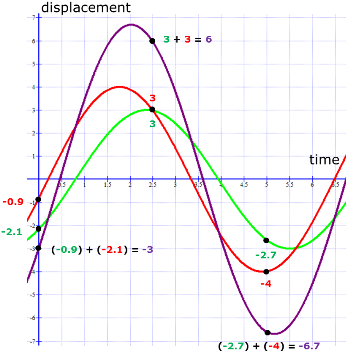What is the principle of superposition of waves?
1 Answer
Jun 7, 2018
Principle of superposition states that when two or more waves meet at a point, the resultant wave has a displacement which is the algebraic sum of the displacements of each wave.
Explanation:
E.g:

Here you can see two waves ( in red and green) superposing to form the resultant wave (in purple). The diagram clearly shows only three points where it shows how the displacement of the resultant wave is calculated.
For example, when time = 0, the displacement of the red wave was -0.9 (signs must be taken into account as displacement is a vector quantity) and the displacement of the green wave was -2.1. As a result, the displacement of the resultant wave will be the vector sum of those, (-0.9)+(-2.1) = -3. This is simply the principle of superposition.

